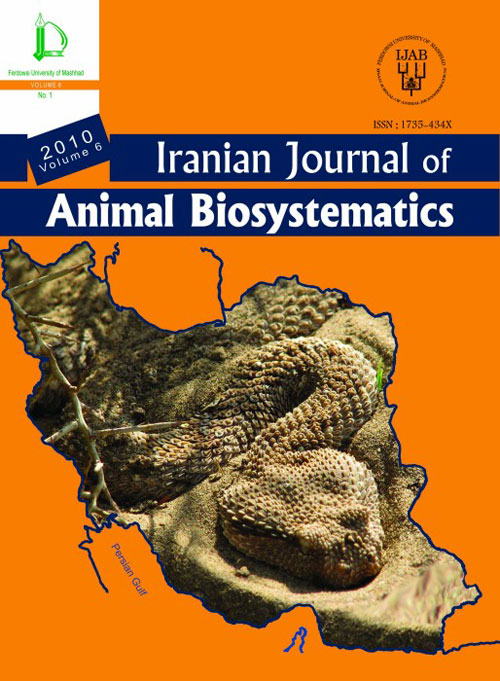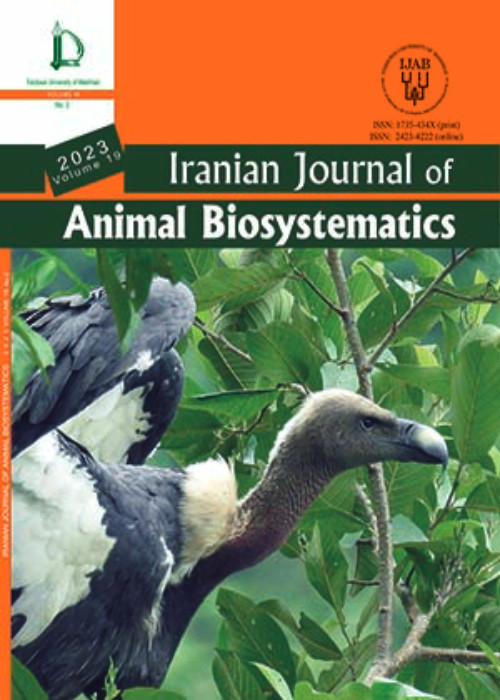فهرست مطالب

Iranian journal of animal biosystematics
Volume:12 Issue: 1, Winter-Spring 2016
- تاریخ انتشار: 1395/10/10
- تعداد عناوین: 10
-
-
Pages 1-35This paper is an attempt to fill all of previous literature of coccinellidae records and species distribution in different provinces of Iran. Distribution was extracted for each species from literatures. There are 6 subfamilies, 16 Tribes, 32 genus and 117 species in Iran. The largest subfamily, tribe and genus in Iran were Scymninae, Scymnini and Scymnus, respectively. The most distribution was for species Hippodamia variegate (Goeze), Coccinella septempunctata L., Oenopia conglobata L., Chilocorus bipustulatus L. and Adalia bipunctata L.Keywords: Checklist, distribution, Iran, Lady beetles
-
Pages 37-50Species identification is always important. Records of sea urchins and sand dollars species ýý(Echinodermata, Echinoidea) is given from Iranian waters. Nine Species of Echinoderms were ýidentified through the study. The species identification was made using morphological ýcharacteristics and review of checklist key. Nine species were identified here, including ýEchinometra mathaei, Prionocidaris baculosa, Temnopleurus toreumaticus, Echinothrix ýcalamaris, Clypeaster humilis, Echinodiscus auritus, Diadema setosum, Diadema savignyi and ýParasalenia gratiosa of which three species namely Echinothrix calamaris, Diadema savignyi ýand Parasalenia gratiosa were new records to Persian Gulf.ýKeywords: Echinoderm, Sea urchin, Sand dollar, Persian Gulf
-
Pages 51-56The present study reports on the first troglophilic terrestrial isopod from Iran. Protracheoniscus faramarzi n. sp. was found in Shafagh Cave, southern Iran. The new species is described and its diagnostic characters are figured. This species is distinguished by the long and narrow antennae, the reduced body pigmentation and the number of ommatidiaKeywords: Oniscidea, cavernicolous, troglophile, new species, Iran
-
Pages 57-66Four Eriophyoid mite species are reported from Golestan province of Iran as new records. They are Tetra salixis (Xue et al., 2006) on Salix caprea Kilmarnock (Saliaceae); Tegonotus depressus (Nalepa, 1894) on Corylus avellana Contorta (Betulaceae); Aceria salviae (Nalepa, 1891) on Salvia sp. (Lamiaceae) and Epitrimerus gibbosus (Nalepa, 1892) on Rubus fruticosus L (Rosaceae).
Morphological diagnostic characters and geographical distribution of the collected species are briefly discussed.Keywords: New record, Eriophyidae, Fauna, Iran -
Pages 67-76Karizes (Qanat) prepare a part of fresh water sources in main desert of Iran. The arid regions in deserts have isolated suitable aquatic habitats as strong barriers, thus only a few places with surface waters have remained accessible for water- related insects. This paper represents the results of only study on dragonfly species of Karizes. We identified 10 species of typical desert dragonflies of four different families that was collected in summer 2013. Some traits allow Odonata to exist in deserts, hence they may reveal some differences with those in non-desert regions. No endemic species was found in this part of the desert. It is concluded that there are typical opportunistic species with special adaptations that colonize in Karizes as a type of aquatic habitats. We reported Ischnura intermedia here as a new record for Iran and noted some differences with the type specimen.Keywords: Karizes, Odonata, Yazd province, Kavir
-
Pages 77-95Five subspecies of the Persian Jird, Meriones persicus, were reported from Iran. These subspecies were described based on morphological characters and coat colors of few specimens. The question of the validity of these subspecies and their geographic distribution is raised. In this study, we combined genetic markers (Cox1, Cytb and IRBP genes), morphometric (external and skull measurments), morphologic (coloration), and karyotypic data to study intraspecific variation in M. persicus in the Iranian Plateau. Three distinct genetic lineages can be recognized in Iran (I, IIA, IIB), and these genetic lineages are separated by natural geographic barriers (Abarkooh, Central and Lut deserts). Our morphometric results also show significant differences between these three lineages, and emphasized morphometric variability within clade IIA, where two subgroups could be recognized. However one of these subgroup was represented by only two individuals in our analyses, and additional morphometric data are needed to confirm this result. Fur coloration vary greatly among Iranian specimens and does not seems to be a reliable taxonomic character. Variation in FNa and morphology of the sex chromosomes was observed between populations, but the determinants of this variation and its significance for taxonomy needs to be investigated. To conclude, this study suggest that three to four subspecies should probably be recognized in Iran, but additional data with more specimens are needed to confirm this result.Keywords: Morphology, Morphometry, Karyology, Molecular, Meriones persicus, Iranian Plateau
-
Pages 97-110Reports on distribution and abundance of bats from Iran exist since mid-nineteen century, but studies on this subject are very scarce and have been conducted very infrequently by European biologists who visited Iran occasionally. Until now, six caves have been investigated and eight species of cave-dwelling bats have been reported from Ilam province in south-western Iran. The present paper has also summarized additional information on 39 distribution records of 11 species in this province. In this study we visited a total of 28 caves, 23 of which contained at least one species of bat. Species recorded in the present study include Rhinopoma microphyllum, R. hardwickii and R. muscatellum from family Rhinopomatidae, Asellia tridens from family Hipposideridae, Myotis blythii, M. emarginatus from family Vespertilionidae, Miniopterus pallidus from family Miniopteridae, Rhinolophus ferrumequinum, R. hipposideros, R. euryale and R. blasii from family Rhinolophidae. M. blythii with 11 distribution records is the most widely distributed species and Khofash cave with four species and about 30,000 bats is the most crowded roost in the study area.Keywords: cave, dwelling bats, distribution, fauna, Ilam province
-
Pages 111-122The highly conserved morphology and chromosomal structures of house mouse, Mus musculus, provides a good model for chromosomal studies. Sex-autosome translocations is one of the rarest chromosomal rearrangements among mammals and therefore sex-autosome translocations has been offered as accurate taxonomic markers to identify species with similar morphological traits. In this study, we described the outcome of a comprehensive cytogenetic survey of the house mouse, Mus musculus, in the eastern Iran using G banding method. Interestingly, results showed the presence of a new cytotype of X-autosome translocation of house mouse which was found in 18 specimens of Birjand region in the eastern Iran. Larger size of choromosomal translocation was observed in Chromosome X. We used karyotype asymmetry method as a powerful statistical parameter to extract coefficient of variation of chromosome length. Based on the data of this study, the results, Birjand population did not show asymmetry in all Asymmetry indexes (AI, DI, As%, A, A2, A1 and Syi%), and this result confirmed translocations in Birjand's chromosomes as well.Keywords: Cytotaxonomy, systematic, Chromosome structure, House Mouse, Karyology, Iran, Middle East
-
Biosystematics of three-toed Jerboas, genus Jaculus (Erxleben, 1777) (Dipodidae, Rodentia) from IranPages 123-139The genus Jaculusis distributed in Palearctic desert and semi-desert areas, extending from Central Asia to the Western Sahara in the North Africa. In Iran three species of three-toed Jerboa have been reported: Jaculus jaculus from the south west and west of Iran, Jaculus blanfordi from the northeast, east and central part of Iran and Jaculus thaleri from the east of Iran. In present study, the phylogenetic and taxonomic relationships in the genus Jaculus from Iran were examined using molecular, geometric morphometric and morphologic data. Our molecular analyses indicated two monophyletic clades which contain J. jaculus and J. blanfordi. There is a high amount of genetic interspecific distance (12.7%) between J. jaculus and J.blanfordi, while the intraspecific divergence within these two species is low. Analysis of Variance (ANOVA) of morphometric variables were significant (PKeywords: Jaculus, Morphometry, Cytochrome Oxidase subunit I, Iran
-
Pages 141-143the manuscript prepared based on the "short notes" format, so abstract is lost.Keywords: Lacerta mostoufii, Lacertidae


